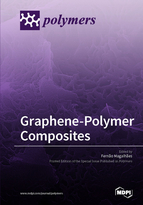Graphene-Polymer Composites
A special issue of Polymers (ISSN 2073-4360). This special issue belongs to the section "Polymer Composites and Nanocomposites".
Deadline for manuscript submissions: closed (5 December 2017) | Viewed by 125277
Special Issue Editor
2. ALiCE, Faculdade de Engenharia da Universidade do Porto, Rua Dr. Roberto Frias, 4200-465 Porto, Portugal
Interests: synthetic and natural adhesives; lignocellulosic composites; graphene-based biomaterials
Special Issues, Collections and Topics in MDPI journals
Special Issue Information
Dear Colleagues,
The mechanical, electrical, thermal, magnetic, optical and biological properties of graphene have attracted a significant amount of attention from the research community since the isolation of single-atom-thick graphene layers, by Geim and co-workers in 2004. Presenting very high surface-to-volume ratio, relatively simple processability and low cost, graphene and graphene-related materials were soon identified as promising nanofillers for polymer matrixes. Reports have shown notorious property enhancements for graphene-polymer composites (GPC) at very low filler loadings. Uses of GPC in varied fields, such as energy, electronics, catalysis, separation and purification, biomedicine, aerospace, tribology, etc., have been demonstrated and, in some cases, put into industrial practice. However, challenges still exist. Platelet agglomeration within the polymer matrix is often seen to hinder performance improvements. Poor interfacial adhesion between filler and matrix is also a limiting factor in many systems, demanding for tuning the surface chemistry to promote physical or chemical interactions with the polymer chains. The range of routes for fabrication of graphene-related materials, leading to different morphologies, oxidation states, and degrees of platelet exfoliation, have an impact on the final properties of the composites that has not yet been fully addressed. Some argue that the potential of graphene, and its advantages in relation to other nanofillers, has not yet been clearly demonstrated for polymer composites.
This Special Issue invites original papers and reviews reporting on recent progress in the following areas:
- Chemical and physical surface modifications of graphene and graphene-related materials for improving dispersibility and compatibility with polymer matrixes.
- Fabrication methods of GPC in coating, film, bulk or particulate forms.
- Properties of GPC (chemical, mechanical, thermal, electrical, magnetic, etc.).
- Biological and biomedical properties of GPC (biocompatibility, antimicrobial activity, etc.).
- Applications of GPC.
It must be noted that the term “composite” should be understood here in its broader sense, describing a material, of any geometry and size, made of two or more constituent materials that do not lose their individual identities when combined.
Prof. Dr. Fernão D. Magalhães
Guest Editor
Keywords
- Graphene
- Graphene oxide
- Composites
- Coatings
- Adhesives
- Fibers
- Particles
- Surface modification
- Surface functionalization
- Materials properties
- Biological properties
Related Special Issues
- Graphene-Polymer Composites II in Polymers (13 articles)
- Graphene-Polymer Composites III in Polymers (9 articles)







